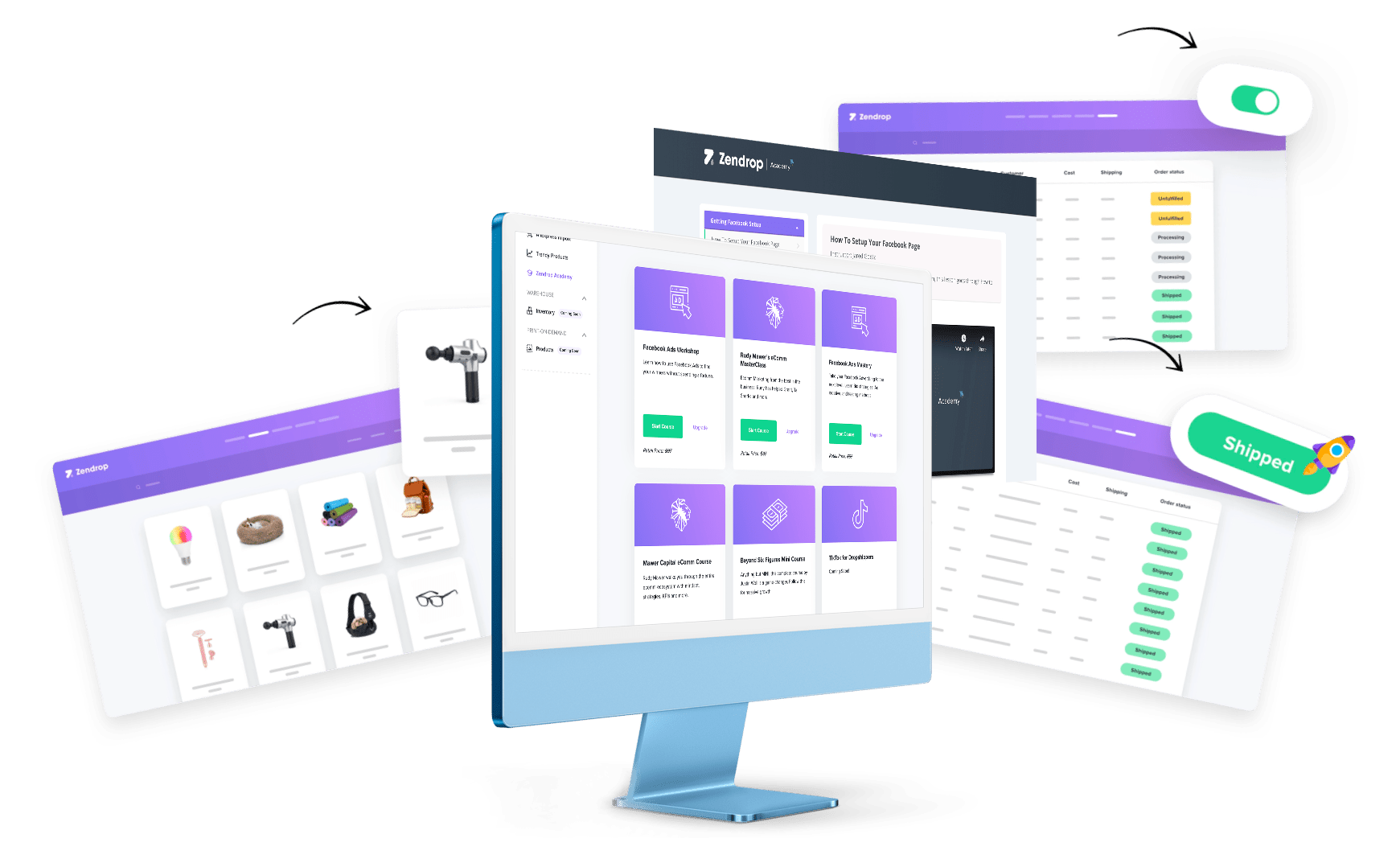If you want to run an online store without the stress of managing inventory, dropshipping is an attractive business model. But how do you find suppliers for the products you want to sell?
For most entrepreneurs, the answer is a dropshipping website or app. These platforms contain directories of suppliers and wholesalers. Many also connect to your store to automate order fulfillment.
Ahead, compare the pros, cons, and costs of 10 popular dropshipping websites.
What is a dropshipping business?
Dropshipping is an ecommerce business model where products sold by an online retailer are stored and shipped by third-party companies.
Rather than purchasing large quantities of stock from a supplier, online stores that use dropshipping purchase a single item from their supplier after a customer has placed an order. The supplier then packages and ships the order to the customer.
Dropshipping has many advantages for first-time business owners. In particular, dropshipping helps those starting a business to save money, time, and resources that would otherwise be spent on inventory management.
Best dropshipping sites: Summary
Compare key features of popular dropshipping sites to help you choose the best one for your business:
How to choose the best dropshipping website?
Most dropshipping websites perform similar functions, but they differ when it comes to costs, product range, policies, and ease of use.
Choose a dropshipping website that works for your business by considering these factors:
- Pricing: Monthly fees, transaction fees, and any additional costs
- Inventory: Niche specialization, product variety, and brand availability
- Shipping: Where suppliers ship products from and to, and how fast
- Key features: Unique functionalities, integrations, and automation capabilities
- Best for: Specific merchant needs and business models
- Shopify app rating: Direct integration with the Shopify platform and reviews from Shopify merchants
Features and pricing can change, so always visit dropshipping websites for the most up-to-date information.

Top Fast Dropshipping Suppliers for Your Online Store
The 10 best dropshipping sites
Shopify Collective
DSers-AliExpress Dropshipping
Spocket
SaleHoo
Zendrop
Modalyst
Trendsi
Inventory Source
Wholesale Central
Worldwide Brands
It can be hard to know where to start when starting a dropshipping business. Even finding a dropshipping website to suit your needs can be overwhelming.
To take the stress out of this process, we’ve reviewed 10 of the most popular dropshipping websites currently used by entrepreneurs.
1. Shopify Collective
List and sell products from Shopify brands using Shopify Collective, a free tool for eligible Shopify users.
Once you’ve browsed products and found an item you’d like to sell, Collective makes it simple to reach out to the supplier and import the product to your store. At checkout, Collective calculates shipping rates and routes the order to the supplier for delivery to the customer.
Product inventory and pricing stay synced between stores, removing the risk of overselling.
If you stock products, you can also use Collective as a supplier. Approve retailers to sell your products through their storefronts and boost your sales.
Price: Free for eligible Shopify merchants. A Shopify subscription is required to use Collective.
Advantages: Partner directly with top US Shopify brands to list and sell their products without the need to keep inventory.
Disadvantages: Currently available to US Shopify merchants making at least $50,000 per year.
Recommended for: Shopify users looking to dropship high-quality products from respected brands.
Shopify app: Yes.
2. DSers-AliExpress Dropshipping
When it comes to product variety, few dropshipping companies can compete with AliExpress. Launched in 2010, the online retail service features more than 100 million products, so you can find something to sell, no matter what niche you’re in.

Ecommerce Shopify Dropshipping Business
If you plan on dropshipping with AliExpress, the best option is to connect a Shopify store to the DSers dropshipping app. With its free plan, the DSers-AliExpress plug-in allows you to explore AliExpress’s enormous collection of products and add them to your store in a few clicks.
Price: Free for up to 3,000 products. The advanced plan starts at $19.90 per month.
Advantages: Large product variety, low cost, and easy to sync with your Shopify store.
Disadvantages: AliExpress is one of the most commonly used dropshippers, so your products may be available at other retailers.
Recommended for: New merchants with lower budgets who can build a strong brand and curate an appealing product line.
Shopify app: Yes.
3. Spocket
Spocket is an order fulfillment service with a wide range of suppliers based mostly in the United States and Europe. But for international stores, this platform also has suppliers in Canada, Asia, Australia, and Brazil.
With the Spocket app, you can browse suppliers’ products and add them to your Shopify store in one click. Spocket also automates the entire order process, with products shipped directly to customers.
Spocket has a branded invoice feature, which lets you create a custom invoice that’s shipped alongside your products. Branded packaging helps with brand awareness and customer retention (and is required for Amazon dropshipping).
Price: To access most features, you’ll need the Starter plan for $39.99 per month.
Advantages: Spocket includes branded invoices that keep your business at the forefront of your customer’s minds. For select suppliers and customer locations, Sprocket offers fast shipping times.
Disadvantages: Spocket can be pricey. Brand invoices are only available on the Pro plan, which offers fewer products at a higher price than alternative dropshipping apps.
Recommended for: Merchants with startup funding who want to brand their own products.
Shopify app: Yes.
4. SaleHoo
SaleHoo is a research tool and supplier directory for dropshippers, wholesalers, and ecommerce stores.
Its database includes over 8,000 wholesale distributors and dropshipping suppliers, with more than 2.5 million products.
With SaleHoo, merchants can access the platform’s Market Research Lab, which provides data and sales insights on products. You can see how well products sell in other stores and online marketplaces like eBay and Amazon before adding them to your own.
SaleHoo also lets you see how many retailers are selling each product, meaning you can factor in competition when positioning your store’s brand. It’s a good resource for merchants looking to put their brand on high-demand products or offer exclusivity on products that are harder to find.
Price: SaleHoo’s dropshipping features start at $27 per month. Access to its database (without dropshipping features) costs $67 per year.
Advantages: SaleHoo gives in-depth information about available products.
Disadvantages: Dropshipping features don’t integrate with Shopify or other ecommerce platforms, so you’ll need to manually import orders.
Recommended for: While there’s no app, SaleHoo has free API resources. Data-focused merchants with experience in custom development can take advantage of this feature.
Shopify app: No.
5. Zendrop
Zendrop is a popular Shopify app that offers both dropshipping and print-on-demand services. It’s a plug-in made by seasoned dropshippers, born out of common frustrations with other dropshipping websites, such as inconsistent suppliers and unpredictable shipping.
As a result, Zendrop has an intuitive interface for adding products to your site—many of which are stored in the US to enable delivery in five to eight days. Merchants can also create custom packaging and subscription boxes to encourage repeat customers.

Top Dropshipping Websites for Shopify Success
How do dropshipping websites help your store?
Since dropshipping delegates much of the work of starting a business to a third party, it has lots of advantages:
Low overhead costs
When you dropship products, you only pay for products after you’ve made a sale, meaning you’ll never have to worry about sinking funds into over-stocking your inventory.
Less startup capital required
Startup costs for dropshipping businesses can be kept lower, since you don’t need to pay to have your products manufactured or stored. The added savings mean more budget can be allocated to assets like paid ads, helping jump-start your growth.
Location flexibility
Since stock is managed by your dropshipper, there’s less need for you to be in a static location. You could work from home, your favorite café, or a secluded cabin deep in the woods (preferably one with decent Wi-Fi).
Fewer risks when testing new products
Most dropshipping sites highlight their bestselling products, meaning you already know what’s currently in high demand.
Saves time
Securing stock, inventory management, and shipping products takes a lot of time. With these tasks delegated to a third party, you can focus on marketing your products and building your brand.
What is the best way to start a dropshipping business?
Let’s take a look at the steps involved in starting a dropshipping store:
1. Find an idea
The first step to starting your business is coming up with a product idea. Remember that, with dropshipping, you’re curating products around a brand, so your primary focus should be on the visual aspects of your brand.
Sometimes the dropshipper itself can serve as inspiration. You could try browsing some of its products and seeing if any fit together or complement an under-served niche.
2. Perform market research
Once you have an idea, you’ll be able to identify your primary competitors and perform a competitive analysis. A competitive analysis is an in-depth exploration of your competitors’ business strategies, target markets, branding, key features, price points, and website design.
Doing this will help you evaluate their strengths and weaknesses, and highlight opportunities to outperform them when developing your own brand.
3. Find a dropshipping supplier
With your market research done, your next step is finding a dropshipping supplier that carries the goods you need to build your brand. There are a ton of suppliers that can be found via the websites listed here, but keep in mind that you don’t have to use a single supplier.
Supplier directories like Wholesale Central and Worldwide Brands are great for finding retailers that carry specific products. They’re also good for brainstorming ideas and spotting underserved niches.
Many dropshipping companies connect directly to products in your Shopify store, so you can sell products from dropshippers alongside your own products.
4. Build your online store
With your dropshipper selected, you’re ready to start your online store. Remember that maintaining your store will be an ongoing process, so you can evolve your product line and branding based on what’s working.
Check out this ecommerce launch checklist to make sure you’ve got everything ready for your grand opening.
5. Market to your audience
With your store live, it’s time to bring in traffic. If you’ve built a social media following or online community, you can direct your existing customers to your store. In most cases you’ll need to start identifying your target audience.
Find online communities dedicated to your product. Attend in-person trade shows and pass out business cards. If you don’t have any, use a free business card maker to create a custom one for the occasion.
Develop a social media marketing strategy to build your following online. And don’t forget to stay tuned to the news in communities that connect with your product for stories on trending products in your industry.
Shopify makes it easy to connect to dropshipping websites
When you start a Shopify dropshipping store, you’ll be able to connect dropshipping apps that automate the process of ordering and shipping customer purchases.


